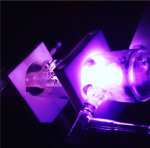After seeing a medium sized Semiconductor production facility at Samsung electronics in SK and the equipment they were using, I must say that most people (
correct me if I am wrong), even with the best consumer grade vacuum pumps, high temperate ovens would be probably hard pressed to grow anything semi-conductor related. InGaN requires vapour deposition in a very high vacuum under high temperatures. It is also extremely expensive as a raw material to acquire. The work to get semi-conductor grade substrates to grow is mind bending even with the best equipment.
I wish all those whom attempt growing semiconductors the best of luck. Its sounds like a great challenge.

 The experience is good on top of the lab experience I am getting as a qc analytical chemist right now. Good idea about finding a computational chemist to simulate the diode as well much appreciated m8.
The experience is good on top of the lab experience I am getting as a qc analytical chemist right now. Good idea about finding a computational chemist to simulate the diode as well much appreciated m8.



